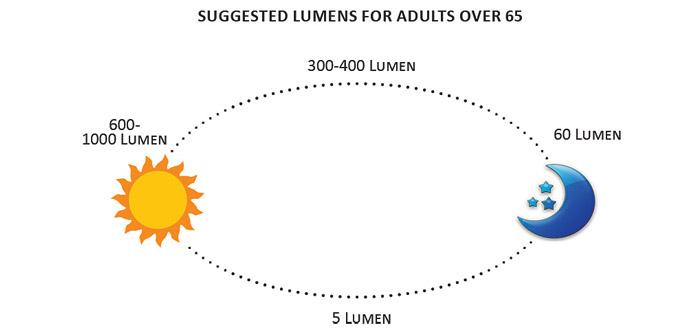The body is a remarkable machine, and like all machines it needs proper maintenance and recharging, especially as you age. According to the Better Sleep Council, a person over the age of 65 needs at least six hours of sleep. Lighting is a key element to create an atmosphere that promotes quality sleep.
By understanding the body’s natural circadian rhythm, or internal clock, that tells us when to sleep and when to wake we are able to design spaces that enhance this natural rhythm rather than counter act it. Incorporating a “24-hour lighting scheme” that mimics light levels from sunrise to sunset supports normal sleep patterns. It also reduces early onset of sleepiness, early morning awakening and daytime napping which in turn increases sleep efficiency and total sleep time. Multiple studies show a reduction in anxiety, agitation and depression when applying a 24-hour lighting scheme.
As a designer of senior living and other residential healthcare facilities, lighting is not only a wellness tactic but a safety precaution. Research shows less falls occur, especially in seniors, for those who are exposed to a 24-hour lighting scheme because they are more alert. It is estimated that the cost of falls and related injuries will reach $32.3 billion in 2020 according to the Centers for Disease Control and Prevention.
How to create a 24-hour lighting scheme?
It seems easy enough – make it light during the day and dark at night. Yes, but you must understand a little about the aging eye to identify what those levels should be. The eye is considered young until the age of 40 and then it begins to decline. As you age, pupils get smaller and the lens becomes thicker resulting in less light reaching the back of the eyes and reducing the ability to see contrast and vividness of colors. Therefore, the aging adult needs a higher level of brightness or what’s referred to as lumen output both during the day and at night.
Typical light levels in senior living facilities are static and not high enough or tuned to the correct color of light to activate the circadian system of older persons. At age 65 we need twice as much light to see as well as we did at age 20. In order to provide a 24-hour lighting scheme, it begins with daily exposure to morning light for one to two hours, especially blue light (most like natural sunlight)which helps our body create serotonin to wake up and synchronizes our circadian rhythm.
In living areas during the daytime (waking to 6pm) it’s important to set the ambient or global lighting levels for the majority of your spaces to 300-400 lumen(bluish-white light) and task areas should be increased by three times to see fine details (at least 1000 lumen). Using as much natural light as possible is preferred in the daytime augmented with cool-white light. Since the older eye cannot completely adapt to dim conditions, illuminance levels in transitional spaces, such as hallways and entrance foyers, should be balanced with those of the adjacent spaces. Having multiple lighting options (i.e. overhead, floor laps, and task lighting) or lights on dimmers helps to adjust the balance throughout the day.
Bedroom or evening lighting should provide a calm and relaxing environment to transition to sleep at about sixty lumen. Avoid blue light waves (including using tablets and watching TV) and focus on neutral, warm tones to help your brain produce the melatonin needed for sleep.
It is not uncommon for aging adults to wake in the middle of the night. Lighting levels throughout the night need to be low enough as to not disturb the circadian rhythm but bright enough to be able to use the restroom and return to bed safely. Instead of turning on overhead lights, night lighting (reddish-orange lighting, less than 5 lumen) along grab bars and around bathroom door frames create a safe environment for the residents and doesn’t disrupt sleep patterns.
What type of lighting should be used?
LED (Light Emitting Diodes) lighting is becoming the new standard. It’s affordable and offers many benefits — lower maintenance costs (lasts longer) and emits higher lumens. New versions allow for different colored light outside of the traditional warm, soft, and bright white.
The installation of a digital lighting systems that automatically adjusts your lighting from day to night ensures the community is providing the appropriate lighting throughout the day without relying on staff to adjust it. These systems can also save energy and reduce costs in addition to creating a comfortable environment.
A full lighting overhaul with new fixtures and a changing lighting system can be expensive but there are many ways to make it cost effective. Options include replacing current incandescent light bulbs with higher lumen LEDs, changing switches to dimmers to easily adjust lighting levels, and adding night lights and accent lighting to doors/grab bars. Experiencing the right light at the right time can keep your body’s natural circadian rhythm– the key to good sleep, good health and wellbeing.
Briana Manfrass is an interior designer with Pinnacle Architecture. In 2012 Briana earned an Evidence Based Design Accreditation and Certification (EDAC) from The Center for Health Design whose mission is to transform healthcare environments through design research, education, and advocacy. Briana can be reached at Briana@parch.biz or 541-388-9897. www.PinnacleArchitecture.com
Lighting Your Way to Health as You Age
0
Share.





